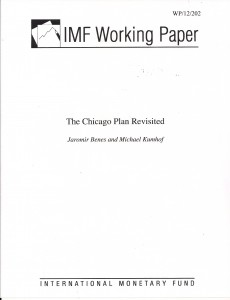

Abstract: At the height of the Great Depression a number of leading U.S. economists advanced a proposal for monetary reform that became known as the Chicago Plan. It envisaged the separation of the monetary and credit functions of the banking system, by requiring 100% reserve backing for deposits. Irving Fisher (1936) claimed the following advantages for this plan: (1) Much better control of a major source of business cycle fluctuations, sudden increases and contractions of bank credit and of the supply of bank-created money. (2) Complete elimination of bank runs. (3) Dramatic reduction of the (net) public debt. (4) Dramatic reduction of private debt, as money creation no longer requires simultaneous debt creation. We study these claims by embedding a comprehensive and carefully calibrated model of the banking system in a DSGE model of the U.S. economy. We find support for all four of Fisher's claims. Furthermore, output gains approach 10 percent, and steady state inflation can drop to zero without posing problems for the conduct of monetary policy.
Safety Copy: IMF Chicago Plan Revisited
Phi Beta Iota: The radical sensibility of this paper, which essentially ends the reign of financial terrorism by Goldman Sachs et al, certainly suggests that in 2011, when Dominique Strauss-Kahn was set up by a maid later found to have been paid, there was already a major schism between Wall Street and the IMF–or among the IMF member states. The paper is breathtakingly brilliant, with all due credit to its antecedents, and we can only hope that the current head of the IMF, Christine Lagarde, will make this the centerpiece of her administration. The other half is the Automated Payment Transaction Tax (APT), which not only doubles or triples government revenue, but also eliminates tax codes and other regulatory means by which legislatures and executives extort money
See Also:
IMF's epic plan to conjure away debt and dethrone bankers
The Global Banking ‘Super-Entity’ Drug Cartel: The “Free Market” of Finance Capital
Goldman, Wall Street and Financial Terrorism



